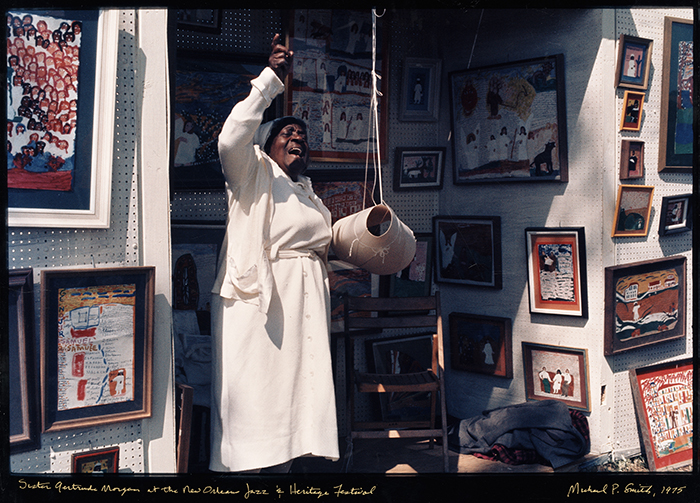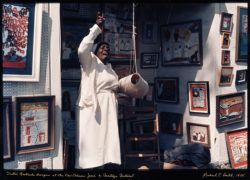Sister Gertrude Morgan
In 1939 Sister Gertrude Morgan moved to New Orleans, where she became a missionary and street evangelist. Music, poetry, and art were the primary tools of her ministry.

Michael P. Smith, © The Historic New Orleans Collection.
Sister Gertrude Morgan surrounded by her art at the 1973 New Orleans Jazz and Heritage Festival.
A self-taught artist who used painting, drawing, and music to preach the gospel on the streets of New Orleans, Sister Gertrude Morgan is considered one of the most significant figures in twentieth-century American folk art. A native of Alabama, Morgan arrived in New Orleans, which she described as the “headquarters of sin,” in 1939. She helped operate a mission in the city’s Gentilly neighborhood for almost two decades before establishing her own house of worship in the Lower Ninth Ward. At this church, she preached, sang, and created the artwork for which she is best known. Graphic depictions of biblical narratives dominate most of Morgan’s dynamic compositions. While New Orleans and its people seldom appear in her work, the city’s reputation for immorality and corruption arguably inform much of her imagery.
Early Life
The seventh child of Frances and Edward Williams, Gertrude Williams was born on April 7, 1900, in the small town of LaFayette, located in east-central Alabama. Records suggest that by 1910 the family had moved to the nearby city of Opelika, or further south to Girard. Approximately seven years later, the Williams family settled in Columbus, Georgia, where Gertrude met and married Will Morgan in 1928. As a teenager in Columbus, she joined the Rose Hill Memorial Baptist Church, but did not experience her first spiritual revelation until 1934. At that time, she recalled, “God . . . turned me into the hands of his son and JESUS said take up your cross and follow me.” Four years later, she returned to Alabama, leaving Columbus and her ten-year marriage behind. In early 1939, after another vision instructed her to “find a new way to speak the Gospel,” she moved to New Orleans.
Life in New Orleans
On her arrival in the city, Morgan met Mother Margaret Parker and Sister Cora Williams, followers of the Holiness and Sanctified movement, an African American denomination known for its syncopated gospel music and expressive form of worship. Dressed in black robes and white collars, the three women worked together as missionaries, preaching on street corners and operating an orphanage and daycare center out of their Flake Avenue home in Gentilly.
In 1957, Morgan had another revelation, this one indicating that she should become the “bride of Christ”—a transformation reflected in the all-white attire she chose to wear thereafter. Soon after this revelation, Morgan moved to the city’s Lower Ninth Ward, eventually taking up residence with Jennie Johnson, an elderly widow who lived on North Dorgenois Street, just blocks from the home of Antoine “Fats” Domino. There Morgan established the Everlasting Gospel Mission, where she held prayer meetings and performed musical interpretations of the Bible for more than twenty years.
Though Morgan reported that she engaged in artistic activity as a child, it was not until the 1950s that she began regularly painting and drawing to enhance her proselytizing oratories. Utilizing diverse media such as crayon, pen and ink, watercolor, and acrylic paint, Morgan created vivid interpretations of scripture on a variety of surfaces such as cardboard, window shades, Styrofoam trays, and salvaged wood. Her works—often executed in bright yellows, reds, and blues, and enhanced by Morgan’s explanatory prose—present scenes from the Old and New Testaments, but she is best known for her depictions of the Gospels and the Book of Revelation. Other renderings, typically done earlier in her career, are secular and autobiographical, offering insights into her experience as a youth. Yet Morgan ultimately intended for her compositions, crowded with dynamic figurative and architectural elements, to tell God’s story and its implication for mankind.
In addition to her painting, an important component of Sister Gertrude Morgan’s missionary work was a repertoire of songs she performed on the streets. Morgan sang and played instruments such as the tambourine, guitar, and piano. While performing on the streets of the French Quarter, Morgan encountered New Orleans property mogul and art dealer E. Lorenz “Larry” Borenstein around 1960. He soon began showing her work at his Associated Artists Gallery, located at 726 St. Peter Street (at present the home of Preservation Hall). Borenstein acted as a patron for much of Morgan’s artistic career, managing the sales of her work, helping her pay bills, and even purchasing the Everlasting Gospel Mission after Jennie Johnson’s death in 1965. Other artists in Borenstein’s cadre included painter and sculptor Noel Rockmore, who completed several portraits of Morgan. In 1971, Larry Borenstein recorded a sampling of Morgan’s music on an album titled Let’s Make a Record. The following year he worked with producers to feature Morgan on the Gospel Stage of the New Orleans Jazz and Heritage Festival.
Later Years
By 1970, Morgan had gained national recognition, her art having had been included in three major exhibitions: in New York City in the Museum of American Folk Art’s Twentieth-Century Folk Art and American Federation of Arts’ Symbols and Images: Contemporary Primitive Artists and at the La Jolla (California) Museum of Art’s Dimensions in Black. In the same year, two of her works appeared on the cover of the program book for the first New Orleans Jazz and Heritage Festival. In 1973, Morgan’s paintings were included in the Museum of American Folk Art’s Louisiana Folk Paintings exhibition, which also featured works by Clementine Hunter and Bruce Brice.
Despite her success, Morgan decided she was done with painting in early 1974. Larry Borenstein later wrote to a friend, “Sister Gertrude Morgan has heard from the Lord that she should suspend her painting and devote herself to poetry.” Shortly after this declaration, Morgan executed works of handwritten, scripture-inspired verse enhanced by bold strokes of color and, on occasion, discreet biblical imagery. Evidence suggests that her eyesight had begun to fail, however, and her works became increasingly tentative. She died in her sleep on July 8, 1980, and was buried at Providence Memorial Park Cemetery in Metairie, Louisiana.
Since Morgan’s death, her artwork has continued to increase in value and popularity. In 2005 the American Folk Art Museum organized the touring retrospective exhibition Tools of Her Ministry: The Art of Sister Gertrude Morgan. Also in 2005, Morgan’s songs found new life when disc jockey King Britt released a critically acclaimed remix of the original album titled King Britt Presents Sister Gertrude Morgan.
